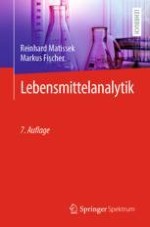2021 | OriginalPaper | Chapter
20. Sicherheitsrelevante/unerwünschte Stoffe – Kontaminanten, Prozesskontaminanten und Rückstände
Authors : Reinhard Matissek, Markus Fischer
Published in: Lebensmittelanalytik
Publisher: Springer Berlin Heidelberg
Activate our intelligent search to find suitable subject content or patents.
Select sections of text to find matching patents with Artificial Intelligence. powered by
Select sections of text to find additional relevant content using AI-assisted search. powered by
